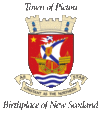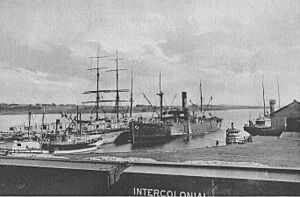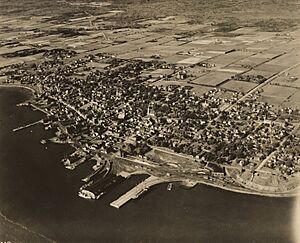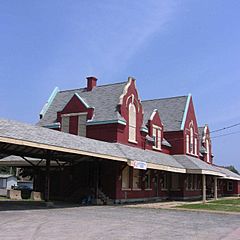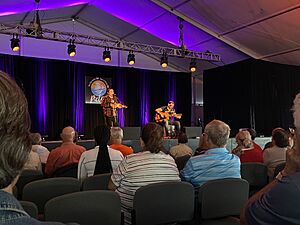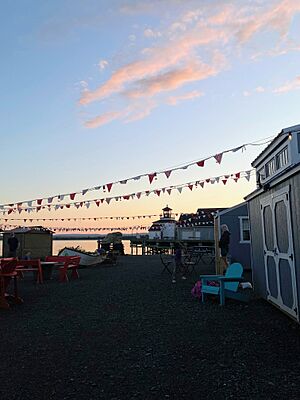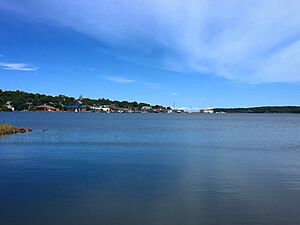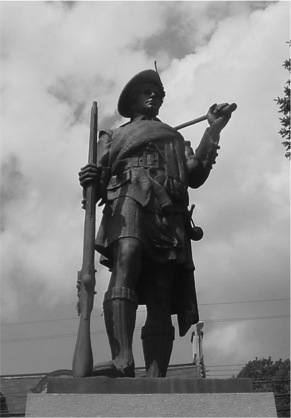Pictou facts for kids
Quick facts for kids
Pictou
Canadian Gaelic: Baile Phiogto
|
||
|---|---|---|

Pictou
|
||
|
||
| Nickname(s):
Birthplace of New Scotland
|
||
| Motto(s):
"As constant as the northern star"
|
||
| Country | Canada | |
| Province | Nova Scotia | |
| Municipality | Pictou County | |
| Founded | 1767 | |
| Incorporated | Apr 30, 1873 | |
| Area
(2016)
|
||
| • Total | 8.01 km2 (3.09 sq mi) | |
| Highest elevation | 54 m (177 ft) | |
| Lowest elevation | 0 m (0 ft) | |
| Population
(2016)
|
||
| • Total | 3,186 | |
| • Density | 397.6/km2 (1,030/sq mi) | |
| Demonym(s) | Pictonian | |
| Time zone | UTC-4 (AST) | |
| Postal code |
B0K
|
|
| Area code(s) | 902 | |
| Telephone Exchange | 485 | |
| Median Earnings* | $55,600 | |
| NTS Map | 11E10 New Glasgow | |
| GNBC Code | CBDPK | |
|
||
Pictou (pronounced PIK-toh) is a charming town located in Pictou County, Nova Scotia, Canada. It sits on the northern shore of Pictou Harbour, about 10 kilometers (6 miles) north of the larger town of New Glasgow.
Pictou was once a very busy shipping port and the main town for the county. Today, it serves as a helpful center for nearby smaller communities. It is also a popular place for tourists to visit in this part of Nova Scotia.
The name Pictou comes from the Mi'kmaq word Piktuk. This word means "explosive place." It might refer to a natural tar or "pitch" found in the area. Another idea is that it describes methane gas bubbling up from coal underground in the harbor.
Contents
Exploring Pictou's Past: A Look at its History
Before European settlers arrived, Pictou was a summer gathering place for the Mi'kmaq people. It was part of a larger Mi'kmaq area called Epekwitk aq Piktuk. This area included what is now Prince Edward Island and Pictou.
How Scottish Immigrants Shaped Pictou
Pictou became a key arrival point for many Scottish immigrants. These families were looking for new homes in Nova Scotia and Cape Breton Island. They came after the Highland Clearances in Scotland during the late 1700s and early 1800s.
The first large group of immigrants arrived on September 15, 1773. They sailed on a ship called the Hector. Even though some Scottish people were already in Nova Scotia, Pictou's tourism slogan is "The Birthplace of New Scotland." This is because it was the first town mainly settled by Scottish immigrants. The Hector is also known as the first immigrant ship to sail directly from Scotland to what is now Canada.
Today, Pictou has many old stone houses built by these early Scottish families. Their designs show clear links to traditional Scottish architecture. When the Hector arrived, a few families were already living in Pictou. They had come six years earlier on a ship called the Betsy.
Pictou's Growth and Industries
In the late 1800s, Pictou's industries grew stronger. A railway line was built to the town, connecting it to other areas. Shipbuilding also increased throughout the 1800s. This was especially true as more coal was shipped from nearby areas. Many shipyards have been operating in Pictou since this time.
A big achievement in shipbuilding was during World War II. The new Pictou Shipyard quickly built 24 cargo ships called Park freighters. After the war, the shipyard continued to build many fishing boats and ferries. The port became even busier after a pulp mill opened nearby in 1965.
The railway service to Pictou ended in the late 1980s. However, new roads like Highway 106 (part of the Trans-Canada Highway) opened in the 1970s. These new routes provided other ways for people and goods to travel.
Who Lives in Pictou? Understanding its Population
| Historical population | ||
|---|---|---|
| Year | Pop. | ±% |
| 1881 | 3,403 | — |
| 1891 | 2,998 | −11.9% |
| 1901 | 3,235 | +7.9% |
| 1911 | 3,179 | −1.7% |
| 1921 | 2,988 | −6.0% |
| 1931 | 3,152 | +5.5% |
| 1941 | 3,069 | −2.6% |
| 1951 | 4,259 | +38.8% |
| 1956 | 4,564 | +7.2% |
| 1961 | 4,534 | −0.7% |
| 1981 | 4,621 | +1.9% |
| 1986 | 4,413 | −4.5% |
| 1991 | 4,134 | −6.3% |
| 1996 | 4,022 | −2.7% |
| 2001 | 3,875 | −3.7% |
| 2006 | 3,813 | −1.6% |
| 2011 | 3,437 | −9.9% |
| 2016 | 3,186 | −7.3% |
| 2021 | 3,107 | −2.5% |
In 2021, the town of Pictou had a population of 3,107 people. These residents lived in 1,452 homes. This was a small decrease from its 2016 population of 3,186.
Pictou covers a land area of about 7.99 square kilometers (3.08 square miles). In 2021, this meant there were about 397.6 people living per square kilometer.
Learning in Pictou: Schools and Libraries
Pictou Academy is the town's high school. It was started in 1803 by Dr. Thomas McCulloch. He was on his way to a new job on Prince Edward Island. However, he decided to stay in Pictou. Dr. McCulloch was concerned about the lack of education in the area. So, he decided to open a "college."
There was a lot of discussion about funding with the Nova Scotia government. But the Pictou Academy finally opened in 1816. The province would not let it be called a "college." However, it was a school for higher learning. It was open to students of all backgrounds and beliefs.
Since 1816, Pictou Academy has been in four different buildings. The first building was moved. The second and third buildings both burned down. Students have graduated from the Academy every year since it opened. The only exceptions were the years between moving to new buildings.
In 2003–2004, most high schools in Pictou County closed. Students began attending two new "superschools." These were Northumberland Regional High School and North Nova Education Centre. Pictou Academy is the only exception and continues to operate.
The town also has a small public library. It includes a C@P site, which offers public internet access.
Fun Things to Do in Pictou: Attractions and Events
Exciting Events in Pictou
The Pictou Lobster Carnival happens every year in early July. It takes place at the old train station. This carnival celebrates the end of the fishing season. It has been celebrated since 1934.
The carnival includes fun rides, concerts, and a pageant. There are also breakfasts, a car show, and fireworks. You can find a beer garden, crate runs, and net cutting contests. Boat races and lobster dinners are also popular. As of 2024, it is the longest-running lobster festival in North America. Thousands of people visit the town for this event each year.
The town also used to host a big Ship Hector Festival in August. This event ended in the early 2010s. However, there are still New Scotland Days celebrations in September. These events focus on the ship Hector. They include a Celtic church service and a reunion for descendants of the original settlers.
In 2023, Pictou celebrated the 250th Anniversary of the landing of the Ship Hector. The town received money from the government for a three-month celebration.
The main events included evening concerts on a waterfront stage. There was also a daily vendor market. A monument for the No. 2 Construction Battalion was rededicated. The church service and descendants reunion were also part of the fun. A musical called Voyage told the story of the Hector. The Governor General of Canada and the Lieutenant Governor of Nova Scotia also visited.
Many famous musicians performed at the concerts. These included Ashley MacIsaac, Cassie & Maggie, and Terra Spencer. Other performers were Mary Beth Carty, Ray Stewart, and Amelia Parker. Christina Martin, Jud Gunning, and Steve MacIntyre also played. Morgan Toney, Darren McMullen, and Rachel Davis were there. Finally, Rum Ragged, Terry Kelly, DeeDee Austin, and the Barra MacNeils entertained the crowds.
Museums and History to Explore
The main tourist spot in Pictou is its waterfront along Pictou Town Harbour. In the 1990s and 2000s, old industrial land was redeveloped. The most important part was building a replica of the tall ship Hector. The ship is now finished and docks there every summer.
The Hector is part of the Hector Heritage Quay. This is a special center with three floors of exhibits. You can also go aboard the replica ship. Next to the Hector Heritage Quay is the Northumberland Fisheries Museum. It also has a Lobster Hatchery and a Lighthouse Museum.
Grohmann Knives Ltd. is the only knife factory in Canada. They have been making famous D.H. Russell Belt Knives and Grohmann Kitchen Knives for over 50 years. You can take free tours of their factory on Water Street.
The McCulloch House Museum is on the edge of downtown. It has an archives and research center. It also features a 19th-century house museum.
Pictou's Unique Architecture
Besides being a museum, the McCulloch House is a 19th-century home. It once belonged to Rev. Dr. Thomas McCulloch. It is one of many old houses in Pictou. The downtown area has several buildings designed in a "Scottish" style. They use local sandstone and have special five-sided dormer windows. A book about the history of each old home and building is available at the museum.
The waterfront area also has a marina for boats. There is a small boardwalk that connects to the Trans-Canada Trail. The historic Intercolonial Railway station (pictured above) on the waterfront has been restored. It connects to the waterfront near the old customs house.
Other Fun Spots in Pictou
There are several monuments around the town. These include the Hector Settler in Market Square. The No. 2 Construction Battalion monuments are on the waterfront. The war memorial (cenotaph) is on Church Street. This memorial was sculpted by the famous artist George Hill.
You can take boat tours with Discover the Strait. They offer different trips to see the harbor and wildlife in the Northumberland Strait. The waterfront also has docks for marine and cruise ships. This allows tourists arriving by boat to stop and visit.
Pictou Town is 5 kilometers south of Caribou. From Caribou, Northumberland Ferries Limited runs a ferry service to Prince Edward Island during certain seasons. There is also a ferry just for people that goes to Pictou Island seasonally.
Several beaches are close to Pictou Town. The most well-known are Caribou Provincial Park and Waterside Beach Provincial Park. The Jitney Trail also starts at the waterfront. This trail used to be a train route. It is now a paved and gravel walkway for people. It runs from Pictou to Oxford, Nova Scotia. The trail also connects to Brown's Point. This spot is just a few kilometers outside Pictou, where the Hector ship first landed.
Famous People from Pictou
Many notable people have connections to Pictou:
- Peter Crerar: A civil engineer who came to Pictou in 1817. He designed and built the Albion Mines Railway. This was the first standard gauge railroad in North America.
- Sir John William Dawson: Born in Pictou in 1820. He lived there until 1840. He then studied geology and natural history in Scotland. He returned to Nova Scotia in 1842. From 1850 to 1853, he was the superintendent of education. In 1855, he became the principal of McGill University in Montreal, Quebec. He held this important position until 1893.
- Henry Hatton: A merchant, shipbuilder, and political leader.
- George Hill (RCAF officer): A flying ace for the Royal Canadian Air Force during World War II.
- William Lowden: Known as the first shipbuilder in Pictou.
- Carmen MacDonald: An ice hockey goalie for the St. Lawrence Saints university team. She won a gold medal with Canada's National Women's Under-18 Team in 2010.
- Christie MacDonald: A famous American stage actress and singer (1875–1962).
- Joey MacDonald: A former professional ice hockey goaltender in the NHL.
- James Drummond MacGregor: The first person in Canada to publish writings against slavery.
- Arthur Stanley Mackenzie: A former president of Dalhousie University.
Ships Named for Pictou
Three naval ships have been named after Pictou:
- Two Royal Navy schooners during the War of 1812 (see: HMS Pictou).
- HMCS Pictou, a Flower-class corvette. This ship served in the Atlantic during World War II.


